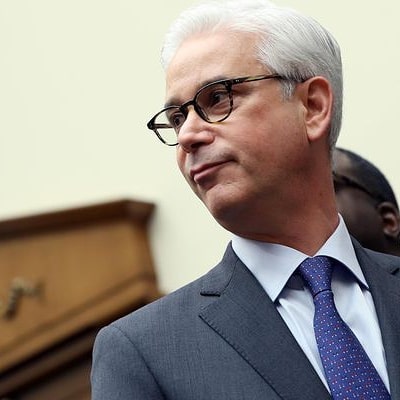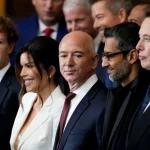Wells Fargo Unleashed: Scharf's Unrelenting Drive to Reclaim Banking Dominance
Once a cornerstone of American banking, Wells Fargo has navigated dramatic highs and lows over its nearly 170-year history. Today, under the unwavering stewardship of CEO Charles Scharf, the $1.93 trillion-asset institution is not just rebuilding trust; it's meticulously modernizing its operations and aggressively refocusing on its core financial services to reclaim its formidable position in the industry.
Charles Scharf's Path to the Helm: The "Chainsaw Charlie" Era
Charles Scharf arrived at Wells Fargo in September 2019 with an urgent mandate: to meticulously repair a bank profoundly bruised by scandal. A Harvard College graduate with an MBA from NYU Stern, Scharf forged his executive acumen during pivotal stints at Visa – where he served as CEO from 2012 to 2016 – and at BNY Mellon. His reputation for disciplined cost-cutting, strategic restructuring, and rigorous risk management made him the compelling choice to lead the turnaround after the infamous cross-selling scandal, which had already seen two prior CEOs depart.
Within months, Scharf earned the evocative moniker “Chainsaw Charlie” for his decisive actions, which included eliminating underperforming units and aggressively slashing discretionary spending. This wasn't merely about cutting costs; it was about surgical precision to streamline operations and reallocate resources where they could be most effective. By the end of 2024, the bank’s board unequivocally signaled their confidence, rewarding his efforts with a $31.2 million compensation package – a 7.6 percent increase on the prior year – comprised of a $2.5 million base salary, a $7.2 million cash bonus, and $21.5 million in long-term equity awards. This substantial package underscored the perceived value of his transformative, albeit sometimes challenging, leadership.
Rebuilding Trust and Modernizing Infrastructure: A Cultural Overhaul
Scharf immediately prioritized a fundamental overhaul of core systems and a radical strengthening of internal controls – efforts directly necessitated by the bank’s devastating 2016 fake-accounts scandal. That episode, where employees secretly opened millions of unauthorized customer accounts to meet aggressive sales targets, led to over $3 billion in fines and, critically, a unique seven-year asset cap imposed by the Federal Reserve.
Under Scharf, Wells Fargo has poured significant investment into its risk and compliance teams, onboarding thousands of new professionals. They have deployed sophisticated fraud-detection software and, most crucially, meticulously rebuilt its entire sales culture. This monumental shift moved away from purely product-sales metrics towards genuinely rewarding positive customer outcomes. While such sweeping changes inevitably present challenges to employee morale and can feel disruptive, the strategic intent has been to instill a deep-rooted culture of ethical conduct and accountability from the top down. Branch renovations, emphasizing collaborative spaces and digital integration, further signal a tangible commitment to a more customer-centric future.
Core Financial Services: A Strategic Recalibration
Wells Fargo steadfastly remains one of the "Big Four" U.S. banks alongside JPMorgan Chase, Bank of America, and Citigroup. Its primary lines of business continue to generate significant revenue, though a strategic recalibration is underway:
- Consumer Banking and Lending: With over 4,100 branches and 13,000 ATMs, this segment remains a cornerstone, serving retail customers with checking, savings, mortgages, and auto loans. While previously a mortgage powerhouse, Wells Fargo is deliberately de-emphasizing home-loan origination in favor of more fee-based businesses, focusing lending more on existing, deep-rooted client relationships.
- Wealth and Investment Management: Through Wells Fargo Advisors and Wealth & Investment Management, this segment provides critical financial planning, brokerage services, and trust administration. This capital-light, fee-generating business has been a key focus during the asset cap period and is poised for continued growth.
- Commercial Banking: Corporate clients rely on Wells Fargo for comprehensive Treasury management, asset-based lending, and equipment financing. This area is a prime target for expanded deposit-taking and lending now that growth restrictions are lifted.
- Wholesale and Investment Banking (Wells Fargo Securities): This division offers underwriting, M&A advisory, and debt capital markets solutions. Having been constrained by the asset cap, this segment is now positioned for significant expansion.
In 2024, the firm reported a robust $82.3 billion in revenue and $19.7 billion in net income, powerfully underscoring a decisive return to profitability and operational stability after years of stifling regulatory constraints. The strong growth in investment banking fees and wealth management income reflects Scharf's strategic pivot towards higher-margin, fee-based businesses.
Turning the Page on Asset Restrictions: A New Growth Trajectory
In a pivotal development in June 2025, the Federal Reserve officially lifted its asset cap, a resounding signal of confidence in Wells Fargo’s extensive reforms and transformed governance. This removal marks the culmination of a painstaking journey and liberates the bank to pursue new growth avenues.
With this significant barrier dissolved, Wells Fargo is now strategically poised to:
- Aggressively expand commercial deposits: Attracting new corporate clients and leveraging its vast nationwide footprint.
- Reinforce Trading & Capital Markets: Scaling up fixed-income and equity trading desks to regain market share and boost fee income.
- Increase lending across core segments: While home lending shifts, the bank can now grow its loan portfolio more broadly, particularly in commercial and investment banking.
This renewed freedom to grow is expected to enhance competitiveness, optimize its balance sheet, and ultimately drive higher returns for shareholders. Investor reaction has been largely positive, with Wells Fargo's stock experiencing a noticeable uplift following the asset cap removal, as analysts now view the bank as "more than a remediation story." However, Scharf has cautioned that the bank remains vigilant, with ongoing regulatory consent orders requiring continued focus on risk management. The road ahead demands a delicate balance: seizing growth opportunities while steadfastly maintaining the rigorous controls painstakingly put in place.
What is Wells Fargo CEO’s salary? In 2024, Charles Scharf’s total compensation was $31.2 million, including base pay, cash bonuses, and long-term equity awards, reflecting the board's confidence in his transformative leadership during the bank's turnaround.
Who is the current CEO of Wells Fargo? The current CEO and President is Charles W. Scharf, appointed in September 2019 and specifically charged with leading the post-scandal transformation and rebuilding trust.
What is Wells Fargo known for? Wells Fargo is best known for its extensive branch network, its diversified financial services—ranging from consumer banking to investment management—and its historic role as a "Big Four" U.S. bank, now also for its rigorous journey of regulatory compliance and internal reform.
Why is Wells Fargo in trouble? The bank’s reputation suffered severely after the 2016 cross-selling scandal, where employees opened millions of unauthorized accounts to meet sales targets. This crisis led to billions in fines, significant leadership changes, and a Federal Reserve asset cap that lasted until June 2025, from which Charles Scharf has successfully guided the bank's emergence.
Under Charles Scharf’s leadership, Wells Fargo is balancing the pursuit of robust business growth with the disciplined governance and cultural transformation needed to definitively prevent past mistakes from repeating. As it capitalizes on its newfound regulatory freedom, the bank’s enduring success will hinge on maintaining this crucial equilibrium – a testament to its arduous journey from crisis to renewed potential.
Related: Uber’s Leadership Crisis: Transforming From Toxic Culture to Ethical Governance














